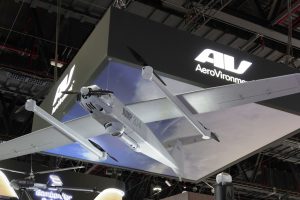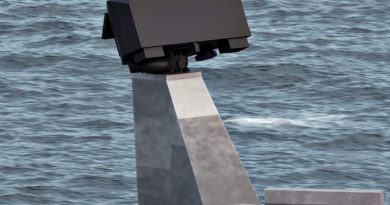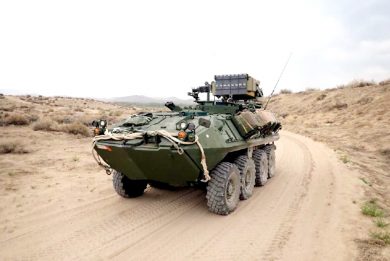IDEX 2025 – First public appearance for AeroVironment Jump 20-X marinized VTOL UAV and first international appearance for its P550
IDEX 2025 marked the first appearance at a defence exhibition of the Jump 20-X, the marinized version of the Jump 20 that AeroVironment developed to answer the requirements issued by the US Navy and the US Marine Corps for a Group 3 unmanned air vehicle (UAV) capable to carry out multiple types of mission. As for the P550, this was its first international show
To survive the harsh conditions found on a naval platform any system needs to be either purposely designed or deeply modified. To answer US Navy and US Marine Corps requirements AeroVironment identified its Jump 20 VTOL UAV, a derivative of its T-20 with added VTOL capability, however this was running on a gasoline engine and needed further actions in terms of corrosion protection and other adaptations.
The result is the Jump 20-X, a Group 3 system that keeps most of the characteristics of the Jump 20 with some major changing. The main one is propulsion, as gasoline is definitely not most welcome on-board naval platforms, the original electronic being powered by a 199 cc gasoline engine with electronic fuel injection located at the front of the fuselage driving a two-blade pulling propeller. This has been replaced by a 230 cc multi-fuel engine, which can therefore run on typical kerosene-type fuel available on board such as JP-8, J-5 and Jet A. Beside the typical modifications adopted on sea-going airframes, the other major upgrade is the adoption of an improved protection against jamming and spoofing, a key feature when using GNSS signals for navigation.
As said, the Jump 20-X maintains most of the characteristics of the Jump 20. The fuselage has a square section and is tapered in the rear portion, which sustains the vertical rudder on top of which we find the horizontal stabilator. The Jump 20-X is 2.9 metres long and features a high straight wing with winglets with a 5.7 metres span. Two narrow pods located around one third of the wing host two rotors each, one forward and one aft, and their related electric motors, batteries being also found in each pod, the VTOL function being all electric, the airframe being capable of automatic take-off and precision autonomous landing. On-board fuel allows for over 13 hours endurance; maximum take of mass is 97.5 kg, while mission payload is 13.6 kg.
The latter is located under the central part of the fuselage, around the centre of gravity, and is usually made of an optronic gimbal and an electronic pod. Depending on customer’s mission requirements the AeroVironment UAV can be fitted with a gimbal containing day/night sensor, usually with a thermal cooled camera operating in MWIR; this can be complemented by a laser designator. In place of the designator other systems can be fitted behind the gimbal; the InsituNSP-3 radar with SAR/MTI/CCD modes together with an AIS receiver is one option; another one is to fit a SIGINT and relay payload; maintaining the SIGINT suite, Northrop Grumman Hatchet miniature precision strike munitions can be added; and finally an option with the optronic gimbal and Corvid Technologies/L3Harris Shryke munitions is proposed. However other solutions may be integrated, providing they fit mass and dimension limits. As for communications, a line-of-sight data link is available as standard, however multiple SATCOM options can be considered to provide beyond-line-of-sight capacity.
AeroVironment is now awaiting contracts from the US Navy and the USMC for its marinised Jump 20-X UAV, the IDEX launch showing well the company strong will to push it on the international market.
Switching to the P550, this was unveiled at AUSA 2024, the Abu Dhabi exhibition being the first opportunity for AeroVironment to showcase it internationally. A smaller, Group 2, all-electric platform with a take-off mass of 24.9 kg, it has a 6.8 kg payload capacity. The front of the fuselage is made of the payload pod, which can be replaced in three minute to reconfigure the UAV for the following mission. The architecture is again with a central fuselage, with a rear boom carrying the vertical rudder with a low tailplane, overall length being 2.8 metres. The mid wing is slightly tapered and carries the typical pods with the front and rear rotors for VTOL operations, while propulsion for horizontal flight is provided by two motors, one on each wing, driving a two-blade pulling propeller. The P550 has as maximum endurance of five hours, the standard Silvus data link ensuring a 40 km range, a digital data link increasing this figure to 60 km.
The P550 is equipped with a visual navigation system (VNS, which elements are in the rear part of the fuselage; these include an infrared sensor, an optronic sensor, a LIDAR and a compute module, the VNS allowing the P550 to operate in GNSS-denied environment.
The P550 can fly at speeds between 30 and 52 knots, has a service ceiling of 14,000 ft and can be launched at altitudes up to 3,000 metres.
EDR On-Line understood that both AeroVironment UAV models are fitted with the company AV’s SPOTR-Edge automatic target recognition system and the Avacore software suite for onboard edge computing. AI algorithms are used to enable autonomous target detection and classification of land and seagoing objects, reducing operators’ workload. They are also equipped with the company precision launch and landing system, which ensures automatic landing on a ship sailing at 27 knots with an error of ±10 cm from the optimal spot.
Photos by P. Valpolini









